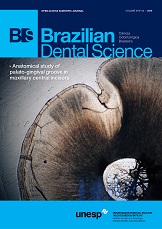Influence of temporary cement in the tensile strenght of full crowns cemented with resin cement
DOI:
https://doi.org/10.14295/bds.2015.v18i3.1106Abstract
This study evaluated the influence of residual eugenol on the tensile strength in the ceromer crowns cementation, using resin cement. Thirty-nine third molars were prepared for a full crown. For each prepared tooth one provisional and one ceromer crown were made. The teeth were divided into three groups according the temporary cement (n=13): GTB: Temp Bond; GTBNE: Temp Bond NE and GDY: Dycal. After temporary cementation, the teeth were kept in distilled water for one week and then submitted to traction test in a universal testing machine (EMIC DL 500), using a 200Kgf load cell at 0.5mm/min speed. After the test, the teeth were cleaned and received the final adhesive cementation of ceromer crowns. Next, the specimens were kept in distilled water (370C) for a week and then the traction test was performed, also at 0,5mm/min. The comparison among groups was carried out by variance analysis (ANOVA) followed by the Tukey test (p?0.05). The results (Kgf) of provisional cementation for groups GTB, GTBNE and GDY were respectively: 2.75 ± 1.35b, 3.43 ± 1.66ab, and 4.48 ± 1.11a. The results of the adhesive cementation (Kgf) were respectively: 42.71 ± 15.33b, 57.59 ± 15.66a, and 54.75 ± 15.28ab. It was concluded that the temporary cement containing eugenol shows negative influence on the removal resistance of crowns cemented with resin cement.
Downloads
Downloads
Published
How to Cite
Issue
Section
License
Brazilian Dental Science uses the Creative Commons (CC-BY 4.0) license, thus preserving the integrity of articles in an open access environment. The journal allows the author to retain publishing rights without restrictions.
=================




























